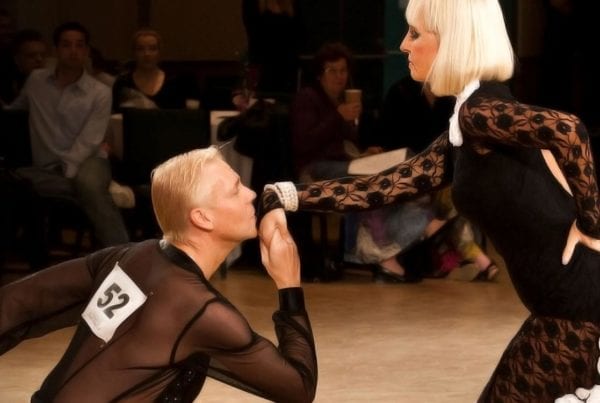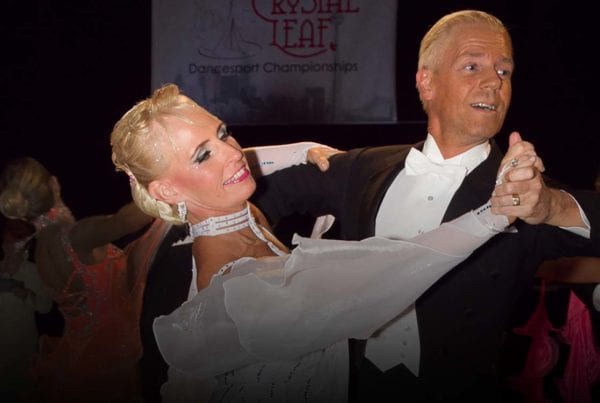Danced well, the Closed Hip Twist is a beautiful basic step with a great story to it and the potential for a variety of ending actions. But it is danced poorly so often that it’s worth a closer look.
Found in Rumba and Cha Cha, the Closed Hip Twist gets its name from the fact that it is danced in Closed (rather than Open) position, and it has a twist of the hips. The lady makes a half turn away from the man and then returns to face him. The multiple endings make this an exceptionally versatile step.
Common Errors
There are a number of places where this step goes wrong. We’ll attempt to cover the most common of these to help improve your Closed Hip Twist. The notes here refer to the Rumba version.
Use of arms alone
A common error is the man’s use of arms alone to lead the lady’s initial turn. This literally pushes the lady off her balance. Note that she begins by standing directly over her left foot, slightly to the man’s right side, with her body weight over the ball of the foot. This position becomes the center point of her rotation to the right. If the man uses his arms in an attempt to move her into her turn, she is no longer centered over that left foot and therefore can no longer turn over that critical center point.
The man needs to turn his body, keeping the arms connected strongly to the body action. Although the technique book says it is a “slight right turn” for the man, I find that many leads in social dancing actually do a better job when they turn a little more, such as a quarter turn to the right as they lead this step. This amount of turn makes it less likely that they will disconnect their arms from their body rotation. As a result, they turn around the lady’s central position, making it easier for her to turn on her left foot and step back onto her right while remaining beautifully balanced. Make sure you have that invisible “beach ball” between your connected arms, allowing a beautiful shape for this movement.
Over-following
Another common issue is that the lady waits to be physically turned. Ladies should never expect the lead to actually turn them. That’s a misunderstanding of the lead/follow roles. All leading and following involves the use of a signal followed by a response. The follow must be ready to move as soon as they get a signal, allowing them to dance on their own and thus to be in charge of their own action. An instant response to the signal leads to an effortless look and a larger, more confident rotation onto the right foot for the lady. Leads should note that you must lead this before the end of the previous beat so that the lady can do this large turn in time to arrive over her right foot on the next beat.
Turning back too early
The most common error, in my experience, happens during the second step, the replacement of weight on count 3 of the music. I can’t even begin the count the number of times that both gentlemen and ladies turn towards each other at this point, one entire beat early. To be fair, the gents often lead this badly and many ladies have simply gotten used to turning back early. This is wrong and destroys the beauty and potential of this step! This second step, taken on count 3 in the music, is simply a replacement of weight to the other foot. There is no turn involved. Turning the lady on this replacement of the foot forces her to turn while her weight is between feet. That’s not only inefficient, but puts her off balance. Keep your arms in position with no turn at all as you replace your weight. The man replaces to his right foot while the lady replaces to the left foot. Let me repeat, because it is so very important: there is no turn on step 2!
Changing weight early
Step 3 of the Closed Hip Twist involves a turn of the lady back to face the gentleman. This is a Pressed Forward Walk for the lady, although I find it easier for social dance ladies if they dance the forward step so small that the ankles remain together. In the Advanced version of the step, there is a strong press line, but not on the basic version. A common mistake here is for either the man or lady, or both, to change weight on this step, which is count 4 of the music. There is no weight change on this step. It is a rotation by the lady over her standing leg (the left as per step 2) to face the man while he turns back to his original starting alignment.
Note that the first and third step are led before the end of the preceding beat of music to make sure that the lady can place herself over her foot on time.
The Hip Twist
At this point we are ready for the actual Hip Twist itself. The man leads this by lowering his left arm while directing her turn with the palm of his right hand. This is all the information the lady needs to respond. He then changes his weight to the left foot. The lady swivels her hip to the right from the core, creating a beautiful rotation, while replacing her weight to the right foot, swiveling the left foot gracefully past the right foot with the ankles together into a forward walk. The gentleman steps back with his right foot. Exiting to Fan position, the man then replaces weight to his left foot and steps to the side while the lady steps across her left foot, turns on her right foot and steps back with her left foot into a perfect Fan position. A common mistake here is simply one of timing, where one or the other partner either rush or delay the timing of this action.
Alternate Endings
There are multiple alternate endings such as a spiral turn for the lady into Counter Promenade Position, which is beautiful. Instead of ending in Fan Position, the man can turn toward the lady on step 6 and follow her in Open Facing Position or close to her in Compact hold to enter a Reverse Top.
In fact, a common option is to bypass the Hip Twist itself, ending the movement early as the man leads the lady across his body on the third step instead of doing the Pressed Forward Walk, providing the setup for a Reverse Top.
A beautiful combination is a Natural Top, Closed Hip Twist and then Reverse Top ending in Fan Position. If the man leads the turn for step 3 early, or if he uses his arms to muscle his partner around, these alternate endings are impossible to achieve because there is no ability to lead anything but a turn back to the original starting position.
Learning to be disciplined in not turning during the weight replacement step 2 action allows the couple to move into the next step with beauty and clarity.













